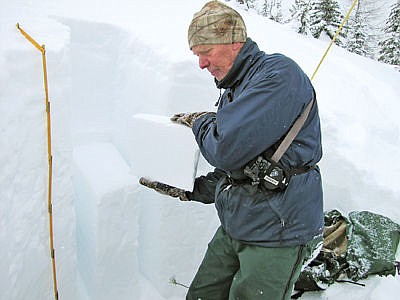Experts teach avalanche safety in Libby
Three local experts offered avalanche safety and rescue instruction to backcountry adventurers, search and rescue volunteers and members of the general public Friday night in Libby.
Nearly 50 people gathered at the David Thompson Search and Rescue building in Libby to hear the presentations from retired United States Forest Service avalanche specialist Jon Jeresek, search and rescue mountain team leader Terry Crooks and Forest Service expert Ben Bernall. The goal of the training, Crooks said, was to help promote safe backcountry recreation.
“The objective is that we’ll all be more aware and we’ll all be safe out there,” he said.
The 2015-2016 avalanche season has seen 10 fatalities so far, with three of them in Montana. The most recent occurred near Swede Creek in the Whitefish Mountain range Jan. 23.
Jeresek taught the assembled participants what he called the obvious clues method of avalanche prediction. The first, and most important aspect, he said, is for recreationists to be aware of the current avalanche risk for the area in which they intend to play. Avalanche injuries and fatalities occur most often, he said, when people ignore recent avalanche activity and warning signs. Contacting the avalanche service center in the area is a critical first step when planning a backcountry skiing, snowshoeing or snowmobiling trip.
Another important piece of the avalanche puzzle is to be aware of the terrain and the signs of pending avalanche activity. Snowpack instability, recent thawing events and heavy snow loading can contribute to unstable snow, which increases the risk of recreationists triggering an avalanche.
Snowpack loading occurs when large amounts of new snow are added to the existing snowpack. Loading can be the result of significant new snow, generally more than one inch per hour for a period of six hours or more. More often, however, snowpack loading occurs as the result of wind. Gusts in excess of 12 miles per hour for any extended period of time can move much higher levels of snow than storms and the relocation of that amount of snow can create instability in the snowpack.
In addition to showing the participants several methods of testing the snowpack stability using a shovel, a tool he said every recreationist should carry with them in their pack, he offered several pieces of advice.
First, he said, people should never go alone into the backcountry. Recreationists should always travel with a partner and everyone in the backcountry should wear a rescue tranceiver to facilitate locate and rescue operations.
Jeresek also advised outdoor enthusiasts to exercise common-sense precautions when recreating.
“Never cross a slope above your partner,” he said. “You also never want to climb a slope to help your partner. Everyone in the party should stop and wait, but don’t go up the slope.”
Other precautions include avoiding parking snowmobiles in a line or in an avalanche run-out area and never, ever, he said, leave a buried partner to go for help. Get them out of the snow before seeking assistance.
Bernall’s lessons overlapped with Jeresek’s, but he added some additional safety tips. First, he said, recreationists should avoid slopes between 30 and 45 degrees, what he termed the “sweet spot” for avalanche risk. To determine the angle of a slope a person should just extend their thumb straight out to make an L-shape of their hand. That represents a 90-degree angle. If the slope is more between one-third and one-half of that angle, it’s risky. Slopes greater than 60 degrees, he said, are generally safe because snow doesn’t accumulate on those slopes, it slides before it can create enough snowpack to become an avalanche risk.
In cases where recreationists have no options other than to cross high-risk terrain, Bernall said they should space out and cross one person at a time, on as high of a point on the slope as they can possibly reach. They should also move as quickly as safely possible and be cognizant of their escape routes ahead of time.
“There are a lot of dead experts,” Bernall said. “Ignorance will get you killed quickly. But arrogance will get you killed just as quickly.”
The course wrapped up Saturday with a field session at Keeler Creek near Troy. The groups conducted a mock rescue and worked in several stations where they learned how to measure snowpack instability and assess avalanche risk.
“The program and the forecasting does save lives,” Jeresek said.



